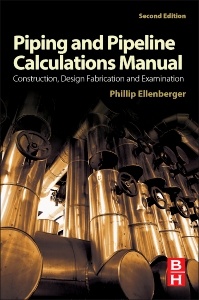Description
Piping and Pipeline Calculations Manual (2nd Ed.)
Construction, Design Fabrication and Examination
Author: Ellenberger Philip
Language: English
Keywords
ASME; ASTM; ASTM Book 1.01; American Society of Mechanical Engineers (ASME); B31; B31-3; B31-J; Barlow; Closure tests; DIN; Darcy factor; Fabrication; Fanning factor; Fluid mechanics; International System of Units (SI); Lame; MSS SP-58; Manufacturers Standardization Society (MSS); Occasional loads; Pipe components; Piping; Piping system; Pressure-temperature rating; Reynolds number; SI-10; Thickness; U.S; customary system; Vibration; actuation; air entrainment; anchor flange; area replacement method; bellows; block; braces; canvass method; cavitation; check valves; code; compressible flow; compressible fluids; control valves; corrosion; creep; creep rupture; damping ratio; degrees of freedom; dimensional standards; earthquakes; equivalent pipe lengths; expansion joints; external pressure; factor A; fittings; flange; flexibility analysis; flow coefficient; flow-induced vibration; fluid transients; friction factor; generic test; hangers; hard conversion; hydraulic radius; hydrotest; ice; incompressible flow; incompressible fluids; intersection; listed materials; mechanical vibration; metal welds; metric; miter bends; nonrigid hangers; operating conditions; pipe bends; pipe denting; pipe flattening; piping; pneumatic testing; pressure spike; proof test; reactions; rectangular tanks; resistance coefficient; resonance; restraints; retarded flow; safety valve; severe cyclic service; slug flow; snow; soft conversion; soil conditions; standard; stress; stress intensification factor (SIF); supports; temperature range; transport fluid; trend curve ratio method; unlisted materials; unretardeded flow; vibration severity; viscosity; vortex shedding frequency; water hammer; wave velocity; wind
412 p. · 15x22.8 cm · Paperback
Description
/li>Contents
/li>Readership
/li>Biography
/li>Comment
/li>
Piping and Pipeline Calculations Manual, Second Edition provides engineers and designers with a quick reference guide to calculations, codes, and standards applicable to piping systems. The book considers in one handy reference the multitude of pipes, flanges, supports, gaskets, bolts, valves, strainers, flexibles, and expansion joints that make up these often complex systems. It uses hundreds of calculations and examples based on the author's 40 years of experiences as both an engineer and instructor. Each example demonstrates how the code and standard has been correctly and incorrectly applied. Aside from advising on the intent of codes and standards, the book provides advice on compliance. Readers will come away with a clear understanding of how piping systems fail and what the code requires the designer, manufacturer, fabricator, supplier, erector, examiner, inspector, and owner to do to prevent such failures. The book enhances participants' understanding and application of the spirit of the code or standard and form a plan for compliance. The book covers American Water Works Association standards where they are applicable.
Chapter 1: Major Codes and Standards?Chapter 2: Metric versus U.S. Customary Measurement?Chapter 3: Selection and Use of Pipeline Materials?Chapter 4: Piping and Pipeline Sizing, Friction Losses, and Flow Calculations?Chapter 5: Piping and Pipeline Pressure Thickness Integrity Calculations?Chapter 6: Straight Pipe, Curved Pipe, and Intersection Calculations?Chapter 7: Piping Flexibility, Reactions, and Sustained Thermal CalculationsChapter 8: Pipe-Supporting Elements and Methods Calculations?Chapter 9: Specialty Components?Chapter 10: High-Frequency versus Low-Frequency Vibration Calculations?Chapter 11: Occasional Loads Calculations?Chapter 12: Slug Flow and Fluid Transients Calculations?Chapter 13: Fabrication and Examination Elements Calculations?Chapter 14: Valves and Flow Control Calculations?
- Updates to major codes and standards such as ASME B31.1 and B31.12
- New methods for calculating stress intensification factor (SIF) and seismic activities
- Risk-based analysis based on API 579, and B31-G
- Covers the Pipeline Safety Act and the creation of PhMSA
These books may interest you

Pipe Drafting and Design 108.13 €



